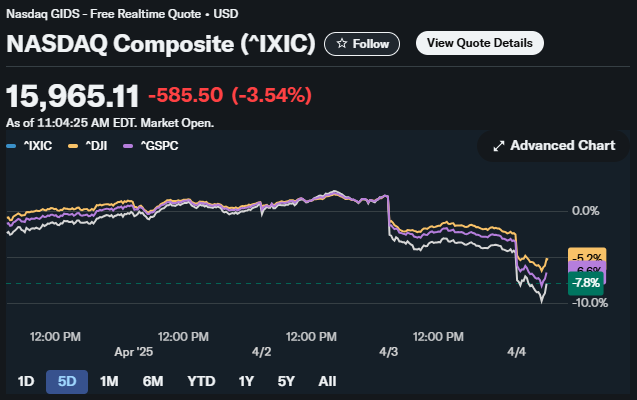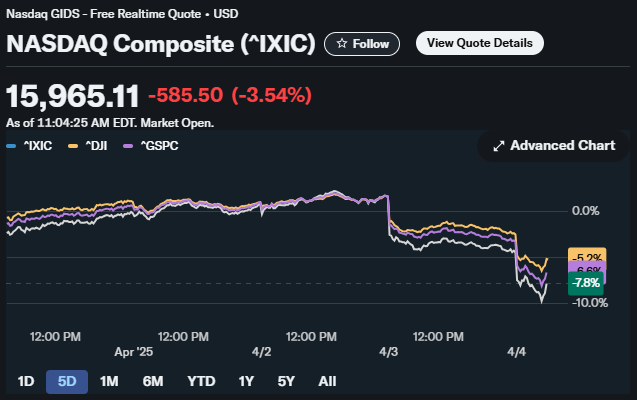Trump’s Tariff Impact: A Market Downturn and Economic Opportunity
“Liberation Day” was a mess. The new tariffs announced by U.S. President Trump were unexpectedly aggressive, featuring a 10% minimum universal tariff and country-specific tariffs of over 50%. This announcement sent shockwaves throughout the global trading system.
Investors reacted swiftly, selling off assets to manage risk in the volatile climate. Consequently, the Dow Jones fell more than 3%, while the Nasdaq Composite experienced a plunge exceeding 4%. The S&P 500 sank by over 4% as well, positioning itself for its worst week since the COVID market crash in 2020.

Additionally, China announced plans to impose a 34% tariff on U.S. imports, mirroring Trump’s new tariffs. This reaction heightens concerns that trading partners may retaliate rather than negotiate, intensifying the ongoing trade war.
Amid the turmoil, however, a potential silver lining is emerging: a significant shift in the economy that may have bullish implications.
The 10-year U.S. Treasury yield’s drop.
This development is not just a minor detail; it could very well be the main event.
Tariff Concerns Drive Down the 10-Year Yield
Earlier this year, the 10-year Treasury yield had reached about 4.8%, a figure that placed hefty pressure on economic activity. The yield significantly affects mortgage rates, business borrowing, and consumer lending.
With the escalation of trade war discussions in March, especially after “Liberation Day,” the yield fell sharply.
Just before Trump’s tariff announcement, the 10-year yield was around 4.25%. By the evening of the announcement, it had dropped to 4.07%. As of now, the yield is approximately 3.93%.
This translates to an over 80-basis-point decline from recent highs. Such a change in the bond market represents significant economic momentum.
I contend that this decline is intentional. It is a strategic policy initiative. Recent comments from both President Trump and Treasury Secretary Scott Bessent emphasize a focus on the bond market, particularly the 10-year yield.
Bessent recently noted, “We’re watching the 10-year, not the Dow.”
In other words, the administration aims to manipulate long-term interest rates rather than artificially boost stock market performance. They appear to prioritize lowering rates, which impact everything from mortgages and auto loans to small business credit lines.
Long-Term Benefits Ahead
This strategy suggests the Trump Administration is targeting economic stimulation at the grassroots level. They are leveraging bond market dynamics, focusing on the 10-year yield.
This makes sense since the 10-year yield plays a vital role in our financial landscape. It serves as the benchmark rate that influences various borrowing sectors, including mortgages, corporate bonds, auto and student loans, municipal bonds, and personal loans.
When the 10-year yield drops, the rates across the board typically decline.
With yields decreasing by over 80 basis points in recent months, we are noticing a corresponding reduction in borrowing costs. For instance, mortgage rates are trending back toward 6.5%, after nearing 8% just a few months prior.
This reduction is significant; lower borrowing costs mean more potential homebuyers can enter the market. Businesses benefit from cheaper refinancing options, consumers gain more credit flexibility, and municipalities can pursue infrastructure projects without the burden of high debt servicing costs.
In summary, lower rates foster increased economic activity. More activity translates into job creation, increased spending, and eventually – greater economic growth.
Tariffs: The Risk-Reward Dynamic
Yet, is this approach a risky gamble? Certainly.
Implementing steep tariffs like 50% is not an endeavor entered into lightly, nor can one expect seamless outcomes from market turmoil.
However, seasoned investors understand that higher risk often leads to greater rewards.
This administration is strategically engaged in long-term planning, viewing the recent tariff announcements as initial moves in a larger game of economic chess.
The overarching goal is to bring global trade partners to negotiations, restore balance, and rejuvenate domestic economic growth while concurrently managing inflation through reduced long-term yields.
If successful, this could represent a remarkable feat of economic engineering: short-term disruptions for sustained long-term benefits.
Currently, the strategy shows promise.
Although stock prices are down, the real economy remains resilient.
- Unemployment stands at historic lows, around 4.1%
- Consumer spending is stable
- Retail sales are increasing year-over-year (3.36% as of February ‘25)
- Business investment holds steady
As the 10-year yield continues its descent, these foundational economic elements could experience renewed support and growth.
Market Response to Lower Rates and Tariff Developments
A second wind is emerging in the market. Lower interest rates are translating into greater affordability, increased financing opportunities, and a higher propensity for risk-taking.
This trend aligns with the stimulus-through-rates tariff strategy that the White House has advocated. Early signs indicate that this strategy is gaining traction.
Currently, investors are focused on tariff-related news, which is understandable given the volatility. However, they may be overlooking a critical macroeconomic development of 2025: a sustained decrease in long-term interest rates. This trend is being intentionally driven by policymakers with the goal of rejuvenating economic activity.
Outlook on Tariff Uncertainty
If the trade disputes are resolved in the coming weeks, as anticipated, current low rates are likely to persist, and the uncertainty premium in the market will diminish.
What does this mean for stocks? They are likely to soar, buoyed by the dual forces of renewed economic growth and accessible capital. This strategy is reminiscent of the run-up experienced during the 2009-2012 and 2020-2021 periods.
While we remain aware of the potential risks—like the severe repercussions of a full-scale trade war—we maintain our perspective:
- These tariffs are to be seen as negotiation tools, rather than permanent fixtures in policy.
- In the next two weeks, we expect deals, not doom.
- With these deals, downside risks are likely to be reassessed quickly.
The 10-year Treasury yield has performed its intended role. Its decline has resulted in lower borrowing rates and has set the stage for the ensuing economic upswing.
However, markets have yet to fully recognize this shift.
This presents an opportunity for investors.
Particularly, stocks in the AI 2.0 sector could embody significant potential, especially those at the heart of the Robotics Revolution. Elon Musk, recognized as the world’s richest person, is clearly investing heavily in this future.
Tesla (Stock-ticker”>TSLA) is leveraging its Optimus robots to execute diverse functions within its factories. It plans to expand production and intends to sell these robots to external businesses next year. Eventually, it hopes to market them to consumers as well.
During a recent Wall Street conference call, Musk asserted that he believes “Optimus will be overwhelmingly the value of the company,” with projections of “the potential to be north of $10 trillion in revenue.”
We view this as a crucial next wave of growth within the AI Boom. However, purchasing Tesla Stock may not be the most strategic way to capitalize on this opportunity…
Discover more about the supplier positioned to gain the most as AI 2.0 progresses.
P.S. InvestorPlace’s Louis Navellier suggests that we are witnessing a fundamental shift in business operations. The underlying objectives of the tariffs remain consistent: to standardize trade conditions, enhance tax revenues, and ultimately foster a substantial wave of onshoring to the United States.
Once the situation stabilizes and the market acknowledges the implications of this significant onshoring trend, the U.S. economy may be on the verge of substantial growth.
To understand what investors should anticipate from the tariffs—and how to find profit in this environment—Louis recently discussed these developments in detail with Luis Hernandez, Editor-in-Chief of InvestorPlace.
Watch the video to gain insights on navigating the markets in the post-Liberation Day landscape.



